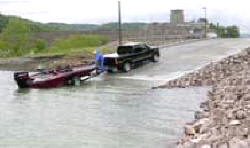Accessible Boating Facilities - A Summary of Accessibility Guidelines for Recreation Facilities
Boarding Piers at Boat Launch Ramps
A boarding pier (sometimes called a courtesy pier or a launch dock) is the part of a pier where a boat is temporarily moored for embarking and disembarking. A boat launch ramp is a sloped surface designed for launching and retrieving trailered boats and other watercraft to and from a body of water. The provisions for boarding piers cover only those that are associated with boat launch ramps. Boarding piers that are not part of a boat launch ramp are classified as “boat slips” for purposes of these guidelines.
If boarding piers at boat launch ramps are provided, at least 5 percent but not less than one, must comply with these guidelines and be served by an accessible route. The exceptions for gangways, previously described above, may be applied to boarding piers (see Accessible Routes).
In addition, gangways connecting floating boarding piers may exceed the maximum slope specified in the guidelines, if the total length of the gangway is at least 30 feet.
ADAAG ramp requirements do not apply to the portion of the accessible route serving a floating boarding pier or skid pier if it is located within a boat launch ramp. For example, a facility provides a chain of floats on a launch ramp to be used as an accessible boarding pier. At high water, the entire chain is floating and a transition plate connects the first float to the surface of the launch ramp.As the water level decreases, segments of the chain rest on the launch ramp surface, matching the slope of the launch ramp. An accessible route must serve the last float because it would function as the boarding pier at the lowest water level, before it possibly grounded out. Because the entire chain also functions as a boarding pier, it must comply with all ADAAG provisions, including the 60-inch minimum clear pier width provision.
Another facility provides a non-floating boarding pier that is supported by piles and divides a launch area into two launch ramps. An accessible route must connect the boarding pier with other accessible buildings, facilities, elements and spaces on the site. Although the boarding pier is located within a launch ramp, because the pier is not a floating pier or a skid pier, no exceptions apply. To comply with ADAAG, the accessible route could run down between the two launch ramps. Or, the fixed boarding pier could be relocated to the side of one of the launch ramps, which would allow the slope of the launch ramps to remain unchanged since the accessible route would run outside the launch ramps.
Boarding Pier Clearances
The entire length of accessible boarding piers must comply with the same technical provisions that apply to boat slips. There is no minimum length for the pier. However, the accessible boarding pier should be at least as long as other piers provided at the facility. If no other boarding pier is provided,it should be at least as long as what would have been provided if no access requirements applied. For example, at a launch ramp, if a 20-foot accessible boarding pier is provided, the entire 20 feet must comply with the pier clearance requirements. If a 60-foot accessible boarding pier is provided, the entire 60 feet must comply with the pier clearance requirements.
Launch Ramps Without Boarding Piers
There are no specific provisions that address access to launch ramps without boarding piers. The Department of Justice advises that if there are no applicable scoping requirements (i.e., how many features must be accessible), then a reasonable number, but at least one, must be accessible. It is recommended that an accessible route serve at least one launch ramp. The portion of the accessible route located within the launch ramp is not required to comply with the slope requirements for accessible routes.


User Comments/Questions
Add Comment/Question